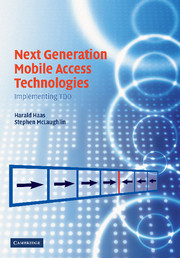Book contents
- Frontmatter
- Contents
- List of abbreviations
- Acknowledgements
- 1 Introduction
- 2 Wireless telecommunications using CDMA and TDD techniques
- 3 Interference and capacity analyses
- 4 Centralised DCA algorithm using the TS-opposing idea
- 5 Distributed DCA algorithm utilising the TS-opposing idea
- 6 UTRA-TDD Opportunity-Driven Multiple Access (ODMA)
- 7 Routing strategies in multi-hop CDMA networks
- 8 Multi-hop DCA
- 9 Radio resource metric estimation
- 10 Interference-based cancellation techniques for TDD
- 11 Smart Antennas for TDD-CDMA Systems
- 12 Cellular OFDMA-TDD
- 1 Derivation of T: Unconstrained Optimisation
- Bibliography
- Index
11 - Smart Antennas for TDD-CDMA Systems
Published online by Cambridge University Press: 02 September 2009
- Frontmatter
- Contents
- List of abbreviations
- Acknowledgements
- 1 Introduction
- 2 Wireless telecommunications using CDMA and TDD techniques
- 3 Interference and capacity analyses
- 4 Centralised DCA algorithm using the TS-opposing idea
- 5 Distributed DCA algorithm utilising the TS-opposing idea
- 6 UTRA-TDD Opportunity-Driven Multiple Access (ODMA)
- 7 Routing strategies in multi-hop CDMA networks
- 8 Multi-hop DCA
- 9 Radio resource metric estimation
- 10 Interference-based cancellation techniques for TDD
- 11 Smart Antennas for TDD-CDMA Systems
- 12 Cellular OFDMA-TDD
- 1 Derivation of T: Unconstrained Optimisation
- Bibliography
- Index
Summary
Introduction
Overview of topic
The last two decades have been witness to the rapid growth and widespread success of wireless communications. This is largely due to breakthroughs in communication theory and progress in the design of low-cost power-efficient mobile devices. Third generation (3G) and other future systems (Nakajima and Yamao, 2001) must provide transmission at a significantly higher data rates as well as a lower tariff per transmitted bit than current second generation (2G) systems. It should be noted that wireless technology is becoming more familiar and common for society. They will also need to address the issue of how many mobiles can be simultaneously served with the infrastructure that the provider has in place. It is clear that we will witness also newer modes and improved services of communication due to progress in radio technology.
The requirements on data rate, link reliability, spectral efficiency and mobility in a fading environment cannot be met with conventional single antenna systems. Therefore, antenna arrays may be used at least on the base station (BS) side to improve performance. Indeed, the new Chinese time division duplex (TDD) system time-division synchronous CDMA (Yang et al., 2002) has been specifically designed for use with smart antenna arrays. Antenna arrays can be used to provide an increased antenna gain and/or an increased diversity gain for each user in the system. At the same time, less interference is received from the other directions (on the uplink) or transmitted to other mobiles (on the downlink).
- Type
- Chapter
- Information
- Next Generation Mobile Access TechnologiesImplementing TDD, pp. 300 - 335Publisher: Cambridge University PressPrint publication year: 2008
- 2
- Cited by



